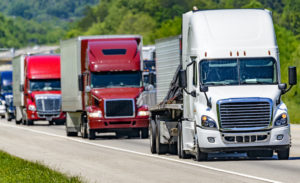Critics hope partnership with cities, manufacturers, fleets and fuel suppliers worldwide will hasten Canada’s rate of fleet electrification

Internal combustion engine commercial vehicles on highway
Critics hope partnership with cities, manufacturers, fleets and fuel suppliers worldwide will hasten Canada’s rate of fleet electrification
On May 28, Canada became the first country in the world to sign an international initiative known as the Drive to Zero pledge, which is aimed at boosting the growth of zero-emission and near-zero emission medium- and heavy-duty vehicles, a category that includes everything from delivery trucks to school buses to 18-wheelers.
The announcement was made by Catherine McKenna, Canada’s Environment and Climate Change Minister, during the day-long Drive to Zero workshop at the 10th Clean Energy Ministerial in Vancouver. The goal of the workshop — which was co-hosted by Clean Energy Canada, the City of Vancouver, and CALSTART, a California-based non-profit and broker for the clean transportation technology industry — was to help governments and industry identify the best path forward for adopting low- and zero-emission commercial vehicles.
Drive to Zero partners include cities, manufacturers, fleets, fuel suppliers, and now for the first time an entire nation — Canada.
The Drive to Zero campaign hopes to make zero emission technology commercially viable in “beachhead” or smaller markets by 2025, building up to the domination of zero-emission technology in commercial vehicle sales globally by 2040. The initiative‘s partners include cities, manufacturers, fleets, fuel suppliers, and now for the first time an entire nation — Canada.
McKenna’s announcement was made in conjunction with the release of a full report by the Advisory Council on Climate Action that recommends steps the federal government can take to reduce carbon pollution in two key areas: the transportation sector and the building sector, which together account for over a third of Canada’s greenhouse gas emissions.
A 2016 study by the U.S. Environmental Protection Agency found that the transportation sector is the largest source of U.S. greenhouse gas emissions, having surpassing the power sector in 2015. Cars and light-duty trucks are responsible for 60 per cent of transportation emissions, while medium- and heavy-duty vehicles produce 23 per cent of transportation emissions.
“Shifting to zero-emission trucks and buses, many of which are made right here in Canada, will cut both carbon pollution and fuel costs. It’s a win-win.”
Merran Smith, Executive Director of Clean Energy Canada
“Canada is well-positioned to be among the leaders transitioning to zero-emission commercial fleets, delivering both environmental and economic benefits,” says Merran Smith, Executive Director of Clean Energy Canada. “We’re a big country and we move a lot of freight by truck. We’re also a heavily urban country, and as cities grow, more is being invested in public transit. Shifting to zero-emission trucks and buses, many of which are made right here in Canada, will cut both carbon pollution and fuel costs. It’s a win-win.”
However, Smith says that Canadian cities have been slow to adopt electric buses compared to a number of American urban centres where battery- and fuel cell-electric trucks and buses, especially transit buses, are already operating. A growing number of U.S. cities are committed to 100 per cent zero-emission transit buses in their fleets — including New York and Los Angeles, which represent the two largest bus fleets in the country.
Among Canadian cities, the current leader is Montreal with 36 electric buses. Toronto has acquired 10 new battery-electric buses and is projected to boost that total to 60, plus an additional 200 hybrid buses, by the end of 2019. Vancouver has four e-buses and Victoria has two. Edmonton intends to put 20 e-buses into service by the summer of 2020, with up to another 28 coming online by 2022.
It’s unfortunate that Canada is lagging behind, says Smith, because we are home to several leading electric bus manufacturers, including Winnipeg-based New Flyer, Vancouver’s GreenPower and Quebec-based Lion Electric and Nova Bus. (This disconnect also points to the economic opportunity in the sector that Clean Energy Canada highlighted in a report released prior to the Ministerial, called “Missing the Bigger Picture.”)
One of the attractions of electric buses for transit fleet managers is their lower operating costs. In a recent pilot project in Edmonton, e-buses were found to reduce operating costs by about 40 per cent. However, the upfront hit of purchasing the vehicles, which are still two to four times more than fuel-powered vehicles, remains an obstacle. Smith believes that hurdle can at least partly be overcome with government incentives. “It’s time for Canada to get on board,” she says.






